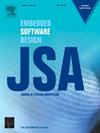Hamun:一种近似计算方法来延长基于reram的加速器的寿命
IF 4.1
2区 计算机科学
Q1 COMPUTER SCIENCE, HARDWARE & ARCHITECTURE
引用次数: 0
摘要
基于reram的加速器显示出巨大的潜力,可以提高DNN推理任务的计算效率,比传统平台提供显著的性能和节能。通过结合自适应调度,这些加速器可以动态调整DNN需求,优化受限硬件资源的分配。然而,由于每次推理执行的多次更新磨损,ReRAM单元的续航周期有限,这缩短了基于ReRAM的加速器的使用寿命,并提出了将其定位为tpu等传统平台的替代品的实际挑战。解决这些耐久性限制对于使基于reram的解决方案在长期、高性能DNN推理中可行至关重要。为了解决基于reram的加速器的寿命限制,我们引入了Hamun,一种近似计算方法,旨在通过一系列优化来延长基于reram的加速器的寿命。Hamun结合了一种新机制,可以检测由于磨损而产生的缺陷细胞并使其退役,从而避免了它们对DNN准确性的不利影响。此外,Hamun延长了基于ReRAM的加速器的使用寿命,方法是在加速器的各个抽象级别上采用磨损均衡技术,并实现批处理执行方案,以最大限度地利用多个推断的ReRAM单元。此外,Hamun还引入了一种新的近似方法,该方法利用dnn的容错特性来延迟磨损细胞的退役,减少退役细胞的性能损失,并进一步延长加速器的使用寿命。平均而言,在一组流行的dnn上进行评估,Hamun的寿命比最先进的基线提高了13.2倍。这一改进的主要贡献者是故障处理和批处理执行方案,它们分别提供了4.6倍和2.6倍的寿命改进。本文章由计算机程序翻译,如有差异,请以英文原文为准。
Hamun: An approximate computing method to prolong the lifespan of ReRAM-based accelerators
ReRAM-based accelerators exhibit enormous potential to increase computational efficiency for DNN inference tasks, delivering significant performance and energy savings over traditional platforms. By incorporating adaptive scheduling, these accelerators dynamically adjust to DNN requirements, optimizing allocation of constrained hardware resources. However, ReRAM cells have limited endurance cycles due to wear-out from multiple updates for each inference execution, which shortens the lifespan of ReRAM-based accelerators and presents a practical challenge in positioning them as alternatives to conventional platforms like TPUs. Addressing these endurance limitations is essential for making ReRAM-based solutions viable for long-term, high-performance DNN inference.
To address the lifespan limitations of ReRAM-based accelerators, we introduce Hamun, an approximate computing method designed to extend the lifespan of ReRAM-based accelerators through a range of optimizations. Hamun incorporates a novel mechanism that detects faulty cells due to wear-out and retires them, avoiding in this way their otherwise adverse impact on DNN accuracy. Moreover, Hamun extends the lifespan of ReRAM-based accelerators by adapting wear-leveling techniques across various abstraction levels of the accelerator and implementing a batch execution scheme to maximize ReRAM cell usage for multiple inferences. Additionally, Hamun introduces a new approximation method that leverages the fault tolerance characteristics of DNNs to delay the retirement of worn-out cells, reducing the performance penalty of retired cells and further extending the accelerator’s lifespan. On average, evaluated on a set of popular DNNs, Hamun demonstrates an improvement in lifespan of over a state-of-the-art baseline. The main contributors to this improvement are the fault handling and batch execution schemes, which provide and lifespan improvements respectively.
求助全文
通过发布文献求助,成功后即可免费获取论文全文。
去求助
来源期刊

Journal of Systems Architecture
工程技术-计算机:硬件
CiteScore
8.70
自引率
15.60%
发文量
226
审稿时长
46 days
期刊介绍:
The Journal of Systems Architecture: Embedded Software Design (JSA) is a journal covering all design and architectural aspects related to embedded systems and software. It ranges from the microarchitecture level via the system software level up to the application-specific architecture level. Aspects such as real-time systems, operating systems, FPGA programming, programming languages, communications (limited to analysis and the software stack), mobile systems, parallel and distributed architectures as well as additional subjects in the computer and system architecture area will fall within the scope of this journal. Technology will not be a main focus, but its use and relevance to particular designs will be. Case studies are welcome but must contribute more than just a design for a particular piece of software.
Design automation of such systems including methodologies, techniques and tools for their design as well as novel designs of software components fall within the scope of this journal. Novel applications that use embedded systems are also central in this journal. While hardware is not a part of this journal hardware/software co-design methods that consider interplay between software and hardware components with and emphasis on software are also relevant here.
 求助内容:
求助内容: 应助结果提醒方式:
应助结果提醒方式:


